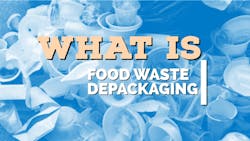Food waste depackaging is the systemic separation of organic food material from its packaging.
A significant portion of food waste is encased in some type of packaging, such as plastic or aluminum. Wastewater treatment facilities are normally capable of handling biodegradable foods — however, the foods’ packaging must removed before the matter within can be properly managed.
Food waste depackaging is the process to separate that biodegradable matter from its non-biodegradable containers.
Wastewater treatment facilities incorporate food waste depackaging processes in order to support co-digestion, reduce operational challenges, feed composting facilities or divert waste from landfills.
How food waste depackaging works
Food waste depackaging can be split into three main processes: food waste collection, the separation of food and its packaging, and the management of the depackaged food.
Collection of food waste
To begin food waste depackaging, food waste collection must first take place. Food waste can be collected from a variety of industrial and commercial sources.
The collected food waste is brought to the wastewater treatment facility for depackaging. A truck or front-end loader can bring the food waste and dump it at a specified location for depackaging.
Mechanical separation of food, packaging
Most food waste depackaging applications for wastewater use mechanical methods to physically separate the food from its packaging.
Food waste depackaging systems consist of a large tank, with a hopper to accept food waste on top or on the side.
Inside the tank, the food is separated form its packaging through either shredding or crushing. Some food waste depackaging systems use screws to shred the food and its packaging, while other systems use hammers to pulverize the waste.
Once the food waste and its packaging have been shredded or crushed, the food can be separated. Some systems add water to the mixture to help ease this separation. Either way, the food becomes a semi-liquid biomass, and can be collected through screening equipment, such as a perforated grate. The packaging material itself is removed from the machine and disposed of elsewhere.
Pumping the depackaged food waste
For a wastewater treatment facility, this depackaging process produces a stream of biomass that can be pumped into anaerobic digesters or composted.
Anaerobic digestion of the food waste can provide energy-rich biomass and biosolids. The high-strength food waste can increase the amount of gas produced by the digesters. Some wastewater treatment facilities may instead add the food waste to its composting process.
The benefits of food waste depackaging
Food waste depackaging is necessary for a wastewater treatment facility to accept most food waste.
According to the U.S. EPA, over one-third of the food produced in the U.S. is never eaten. This level of waste leads to challenges for space and pollution on a massive scale.
A wastewater treatment facility can incorporate food waste depackaging to turn itself into a sort of regional collection facility for food waste. For wastewater utilities, some of the greatest benefits of accepting food waste are enhanced co-digestion, landfill diversion and greenhouse gas emission reductions.
Enhanced co-digestion
Co-digestion involves combining wastewater sludge with other high-strength organic waste, including fats, oils and grease (FOGs) and food waste. This organic matter can then be anaerobically digested to produce biogas and biosolids — useful products that can benefit a wastewater facility financially.
Some other wastewater facilities employ composting to turn their wastewater sludge into a usable biosolid. Food waste, after it is separated from its packaging, can be added to this composting process.
Landfill diversion
When a wastewater treatment facility accepts and manages food waste, a significant benefit is landfill diversion.
EPA says that food waste “is the single most common material landfilled and incinerated in the U.S., comprising 24 and 22% of landfilled and combusted municipal solid waste, respectively.”
A wastewater utility can accept and process food waste, conserving significant space for landfills.
Greenhouse gas emission reduction
As food rots, like when it is in a landfill, it produces the powerful greenhouse gas methane. A wastewater treatment facility can capture this methane for usable biogas.
If a wastewater utility begins to accept and depackage food waste, this turns a harmful greenhouse gas into an economic boon.
Challenges behind food waste depackaging
Food waste depackaging also comes with unique challenges. The specialized processes of depackaging introduces new costs and wastewater facilities are not always the best destination for food waste.
New costs of depackaging
Accepting food waste at a wastewater treatment facility means added costs for the facility.
The purchasing and installation of food waste depackaging equipment is one major cost that the facility will need to incur. Then, the facility will need to spend time and resources to maintain the equipment and train personnel to handle it.
In addition, the facility will need to dedicate labor, space and resources towards the processes behind acquiring food waste: the facility will need designated time and space to receive and depackage food waste. A community may also need to develop a centralized food waste collection program before the facility can accept the waste.
Food waste may have better destinations
In the 2023 EPA report “From Field to Bin: The Environmental Impacts of U.S. Food Waste Management Pathways (Part 2),” the agency rates anaerobic digestion as one of the least preferred methods of food waste management.
When it comes to reducing the environmental impacts of wasted food, EPA rates “anaerobic digestion with beneficial use of digestate/biosolids” as less preferable than other pathways: using the waste to feed animals, leaving the waste unharvested, and donating/upcycling the waste are more preferred.
Managing food waste through a wastewater facility can still lead to significant uncontrolled methane emissions. EPA argues that these emissions far exceed the benefits of energy recovery technologies.
Food waste depackaging summary
Food waste depackaging is a necessary process for a wastewater treatment facility to receive and manage large quantities of food waste.
Managing this food waste can free space in landfills, reduce pollution and generate usable biogas. To that end, food waste depackaging helps to minimize waste and promote a circular economy.
About the Author

Jeremy Wolfe
Jeremy Wolfe is a former Editor for Wastewater Digest.
